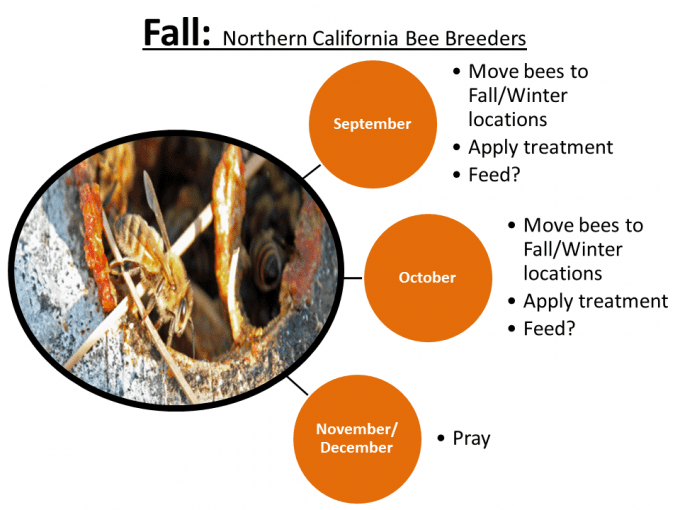
This is the final installment of a 3 piece blog that summarized a year in the life of a Northern California Bee Breeder. We are quickly approaching the end of October and beekeepers in the area are closer and closer to giving their bees a much needed rest. October and November are the culmination of a year’s work. It’s make or break time for most and what you have is what you got and hopefully what you will end up with at the start of the new year. There is no time for re-queening, no hope for a miraculous turn around, and nothing more to do then asses what you’ve got and add a clean-up treatment and/or one more round of feed.
At this point, Varroa mite and Nosema levels are a reflection of how well you’ve managed your hives throughout the year. If all is well levels will be low enough to get bees through the winter and well into the spring without having to use medications on hives designated for breeding. Much of what we have been doing this fall is sampling operations for Varroa and Nosema levels pre and post-treatment. This helps the beekeepers in several ways: 1) Pre-treatment samples help beekeepers determine infestation levels which can regulate how aggressive they need to be with their treatments, 2) Post-treatment samples help beekeepers gauge the effectiveness of their treatments which can help determine if any further treatments need to be applied, and 3) A final round of sampling just before winter sets in adds an extra level of comfort and provides peace of mind (this is, of course, only true if mite and Nosema levels are low).
It is particularly important for commercial bee breeders to have Varroa and Nosema levels as low as possible going into winter because they don’t like having to use antibiotics or chemical miticides on hives used in their breeding operations. This is especially true for those colonies designated as breeders and drone mothers. Breeders consist of the best of the best in any beekeeping operation. They are the hives selected using the strictest criteria exhibiting the most desirable traits. They are always the biggest, strongest, healthiest, and most productive of all hives. Anything that was in the running to be a breeder but for one reason or the other did not meet the selection criteria for a breeder will be used as drone mothers, supplying drones for the daughters of the breeders to openly mate with. A good rule of thumb is to make one 2-story drone mother available for 20 mating nucs. Because of this, the size of a given operation usually dictates the amount of queens that operation can produce throughout the year.
In order to produce thousands of viable queens, breeders need to mate thousands of virgin queens. This is no small task given the variables, most of which are very hard to control (i.e. weather and predation). To mate thousands of virgin queens a breeder needs hundreds of impeccable drone mothers. There is both scientific and anecdotal evidence that suggests the use of certain medications (antibiotics and chemical miticides) can negatively impact the reproductive potential of honey bees. However, without the use of medications to treat things like Varroa mites and Nosema, infestations can become so severe that honey bees are unable to vigorously mate. Beekeepers are constantly weighing the costs and benefits of applying medications. Bee Breeders participating in our program are trying to ensure the quality of the queens they are producing over the quantity by making informed treatment and management decisions.